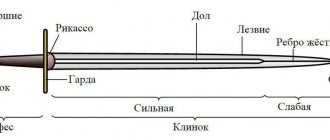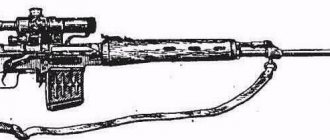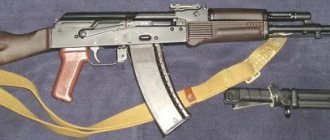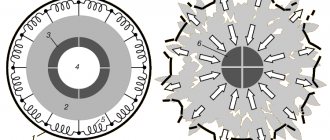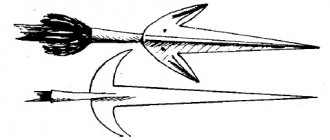In our human history, wars have constantly taken place, but the peasants have always remained the most unprotected group, since they did not have combat training and high-quality weapons. In order to also go into battle and protect themselves, their home, their family and country, people simply used what they had at hand.
By modifying initially peaceful working tools, a special class of highly effective military weapons is created - scythes, chains, and combat sickles. The most popular and widespread example of this weapon is the scythe. Let's take a closer look at the features of using the scythe and why it became so popular among peasants during the war.
History of appearance
It is not known exactly when the ordinary braid appeared. According to some sources, we can conclude that it was known back in the early Middle Ages. The use of scythes as weapons was recorded in the 14th-16th centuries, although it was most likely used even earlier. Life in those days was harsh, and if every peasant had an ax on the farm, then only hunters had spears. But the scythe could quickly become a weapon operating on the principle of a wide chopping spear.
After simple manipulations to straighten the joint, the scythe could already be used as a bladed weapon, which made it possible to keep the enemy at a distance. This weapon proved to be especially effective in battles against horsemen. There was even a special style of fighting, when one peasant would clip the legs of a horse with an ordinary scythe, and the second would quickly kill a rider falling from his horse with a combat scythe.
The first written mentions of the use of combat scythes can be found in chronicles of the 14th century. It was these braids that were used by the Swiss infantrymen, who were recruited from the peasants of the cantons of Uri, Unterwalden and Schwyz. In the battle against the Austrian knights, the battle scythe showed itself to be a real weapon of death.
The combat scythe was used during the “Hussite” wars and during the “Great Peasant War” of 1525. It may seem that the use of combat scythes is due to the inaccessibility of other weapons, but this is far from the case. Against the knightly cavalry, it was the battle scythes that could compete on an equal footing with the pikes. Since it was unusual for yesterday’s peasants to wield a pike, they preferred to use combat scythes, which they had been familiar with since childhood.
In battles with knightly cavalry, combat scythes were used as follows:
- If the scythe had a hook, then it could be used to pull the knight off his horse;
- The combat scythe was very convenient for cutting the sinews of horses;
- A slash from a scythe could cut off a head;
- The battle scythes placed forward were used as pikes.
Although the battle scythe was a fairly heavy and large weapon, the peasants who were accustomed to them cut with extraordinary dexterity.
Examples[edit]
Mythology[edit]
- With a screwed wick - Titan Kronos. He had not a scythe, but a sickle; and with it he did not fight with his father Uranus, but only castrated. After which the gun was thrown into the sea. According to Golosovker, the same sickle that Kronos wielded was later used by the titan Argus Panopt, who, on the orders of Hera, used it to kill Aigipan (the foster brother of Zeus), known under the nickname of the Terrible Satyr of Arcadian, and his wife the serpentine Echidna. By the way, again according to Golosovker, this sickle is the only weapon capable of destroying the titans, who, in principle, are immortal.
- Saturn, the Roman equivalent of Kronos, is often depicted with a scythe. But, again, nothing is known about its use in battle.
- With the wick screwed on, for most serious authors, Death is not a killer, but a guide and witness. Such a scythe cannot be called a combat braid.
Literature[edit]
- “A Song of Ice and Fire” - on the Iron Islands, in the coats of arms of different branches of the House of Harlow, a scythe is depicted (only the color of the coat of arms differs). The scythe is not a combat one, but an agricultural one. The King of the Isles proudly bears the title of High Lord Reaper. Because the philosophy of the ironborn invaders is to reap, not sow. The tightly frozen leader of the Wildlings, the Weeper, fights with a scythe.
- And the scythe of Death eventually destroyed the New Death, his evil successor.
of Death here is the sword. And the scythe is a tool.
Well, or so he thought (and there is no point in taking the word of the god of deceit) . GG hoped that the scythe would not be found for him and he would not have to demonstrate “specialization.” Found. I had to study.
,” since these weapons did not help them against Meph and Varsus.
Cinema[edit]
- "Scarecrows"!
- “Jack the Giant Killer” (1962) – at the beginning Jack killed the giant with his scythe.
- “Killer vacation” - with a screwed-on fuse: this is how the “students” perceived it when Dale approached them with this agricultural tool in his hands and tried to establish communication at the first meeting. His nervous laughter only made everything worse.
- “Bloodfest” - serial killer Gardener, a huge bearded man in dark glasses and an apron, uses all kinds of pruners and... yes, her own.
- "Wild East" - When the Skull realized that his game of "seven deaths" had been exposed, he tried to use this Noseless attribute against the Traveler. Unfortunately for the Skull, in addition to the Mauser with one cartridge, the Traveler had one more argument...
TV series[edit]
- "Grimm." Scythes are the weapon of creatures called Reapers. It is with them that the Reapers kill the Grimm.
Animated series[edit]
It's also a cannon!
- RWBY - both the main character Ruby (in the picture) and her beloved Uncle Qrow are fighting with amazingly large mechanical scythes, which are also amazingly large guns. Crow, however, prefers the sword mode, and in general it is highlighted that the scythe is an incredibly difficult weapon to master (even experienced user Crow had it knocked out of her hands in battle, and 15-year-old Ruby lost her scythe in battle countless times...). Crowe was inspired by the weapon of the Grimm Reaper Maria Calavera
- two scythes like Death from Darksiders II.
Anime and manga[edit]
- Digimortal, a short manga by Tsutomu Nihei - the main character wields a scythe.
- Getter Robo: mecha with scythe - cool? What if this scythe is made of pure energy, and of such a size that it can cut several moons of Jupiter with one stroke?
- Gundam Wing: Gundam Deathscythe and Gundam Deathscythe Hell in the hands of Duo Maxwell mowed down enemies like grass if necessary.
- Hellsing: Zorin Blitz! The moon shines under the scythe, and the star burns in the forehead...
- Naruto - Hidan, a priest of the god of death Jashin/Dzyashin, is armed with a scythe.
- Bleach: In Nnoitora Jilga’s ressureksion, the “sword” (also of an unusual shape, by the way) turned into four braids. And Hisagi Shuhei’s sword, Kazeshini, when opened, turns into paired kusarigama (see Real Life).
- In the feature film Fade to black I call your name, Rukia, taken under control, was armed with a scythe
.
Video games[edit]
- Castlevania: of course, the permanent boss is Death. Strives to reach the player with a large scythe, and also launches small sickles at him. In some games in the series, the player can also mow down enemies with a huge scythe.
- In the fifth part, the second most powerful undead unit is the wight. The necromancer hero is also armed with a scythe, but does not use it in battle. There, the militia wields a glaive made from a scythe.
- In the sequel, we play as Death himself, who is entitled to this weapon according to his status. And this comrade has more than one or two braids. Although, judging by their size, these are most likely kamas.
- But in the Median XL mod, one of the most powerful necromancer builds is designed to use a scythe. And no wonder: according to the crazy logic of the developers, the scythe is classified as a dagger! So all sorts of necromantic skills like “poisoned dagger”, multiplied by this two-handed bandura... In the “Grapes of Wrath” fashion, the scythe also rules. Not entirely true: the necra's melee special abilities work with either a scythe or a dagger, because both are signature weapons.
- Demon's Souls: There is an authentic war scythe (Warscythe) with the blade parallel rather than perpendicular to the shaft.
(death magician) is armed with a wand, symbolizing a scythe. His main ability is
Reaper's Scythe
- outright kills a hero who has less than 40% of his life left.
- Desolator is a real braid!
- In general, some of the staves look like braids. And in addition to various spellcasters, paladins and warriors can wield staves. If the scythe is picked up by a death knight dressed in a black hood, in appearance he automatically turns into Death with a Scythe.
, striking at a distance of up to 20 meters.
- Da Capo - E.P.O.S. weapon of the Silent Orchestra and Despite the End - E.P.O.S. weapon of the unrealized anomaly The Price of Silence. Both scythes are ALEPH-class weapons, with the highest requirements for the agent and cause corresponding damage, and to obtain them you will have to work hard, because the original anomalies are dangerous and very capricious in operation.
Board games[edit]
- Warhammer 40,000: Mortarion and his associates (Death Shroud, Typhus and some other commanders) are armed with huge battle scythes with the terrifying name Manreaper (how to translate this? “Man-cutter”? “Man-reaper”?). Mortarion's personal scythe is called Silence. And yes, they fight on the side of the god of disease and death, and their braids have one “pleasant” additional effect. By the way, on Barbarus, the primarch cut down the undead with an ordinary agricultural scythe, and only then stole the weapon of his adopted father, the main despot of Barbarus.
- C'tan Nightbringer, the most literal Grim Reaper. The Necrons also have Warscythes in their arsenal, but until recently these things were not very similar to scythes - more like glaives.
- Maugan Ra, one of the Phoenix Lords of the Eldar. His battle scythe is also a freaking big gun. More precisely, first of all, a big gun. And death jesters, similar to the Harlequin version of the dark reapers.
- And many individuals of tyranids have paws that end in one hefty claw, which looks like a scythe.
- Subversion with the Space Marine Order Scythes of the Emperor: they only have scythes on their emblem, they fight with the same weapons as the other orders.
- But the Order of Mortifactors uses quite real power battle scythes.
- Knights of the Order of the Sacred Scythe, imperial specialists in the fight against vampires.
Music[edit]
- Song “Combat Prosthetics” (subversion, but, like everything else with them, open banter):
| « | If we take prisoners, then we torture and beat them - Our battalion commander loves interrogations! With a drill on the stump, Even the legs are sharpened into sharp braids. | » |
| — Belomors Group | ||
Real life[edit]
(link)
Why is it not very practical (in English) Scythe? No, sickle!
- A combat scythe is obtained if the blade of an ordinary scythe is attached to the holder not perpendicularly, but parallelly, so that a kind of glaive appears. This is how they were made by assorted militias and rebels. Hitting an enemy with the inner blade of a simple scythe is almost impossible, but in works of fiction this is usually ignored. In the 1794 uprising led by Tadeusz Kościuszko, such peasant militias were called cosigners
. - In general, the traditional agricultural scythe is not very suitable for the role of a military weapon. Its blade is a bit thin: it is clearly easier to mow grass or grains than enemies, and the scythe does not need extra weight - the mower will get tired faster. And if the braid has a curved handle, this is completely inconvenient.
- However, some fencing books include engravings with fighting techniques using a “perpendicular” scythe.
- Romfeya - the name of the weapon has the same root as in Russian rub
it. This is just an example of giving the blade a slightly curved shape for a better chopping blow - for example, like in a katana, checker or scimitar. The resemblance to the scythe here is simply an example of convergence. And by the way, the Thracians already owned it in the Iron Age, and this metal is far from being as expensive a rarity as, for example, copper.
- And also kusarigama - the same thing, but an iron ball on a chain is attached to the other end of the handle.
Weapon Description
A combat scythe is a very simple weapon, consisting of a shaft and a blade, which, unlike an agricultural tool, was directed vertically (that is, forward). To do this, it was either reforged or simply inserted into a split shaft, additionally secured with rivets or hoops. Often the upper part of the shaft under the blade was protected with wire or metal strips from being cut. As a rule, the combat scythe had a double-sided sharpening. Often, during reforging, the blade of a combat scythe received additional elements (spikes, hooks), thus turning into a full-fledged halberd.
In Europe, the so-called assault scythe (Sturmsense) was known, which, in addition to the sickle-shaped blade, also had an awl-shaped process directed forward.
It should be noted that the classification of these weapons is somewhat confusing. Many authors consider the combat scythe not a separate type of weapon, but a type of guizarma. Functionally, the Japanese naginata, the Russian sovnya and the Chinese halberd guan dao are close to the combat scythe.
If we talk about combat use, the scythe was more effective than the pike. Because the latter could only deliver piercing blows, while the combat scythe could also chop and cut.
Knight's spear
I take my hat off to whoever can withstand the blow of a knight's spear.
Yes, all of the weapons listed can kill if used correctly, but of all the weapons mentioned, they either crush, chop, cut, or pierce. In many cases, the victim survives or dies soon after, within a few days. The name of the word "spear" comes from the word lancea - "javelin" of the Roman auxiliary or throwing impact weapon. Although according to the Oxford English Dictionary (OED), the word "spear" may be of Iberian origin. Also the entomology word λόγχη (lónkhē or "spear"), has Greek roots for the terms "javelin" or "spear".
A spear in its original sense was a light throwing weapon, or dart. The English verb for action: "throw, hurl, hurl" comes from the term (old French) and also from the rarer or poetic lance ‒ "spear".
The 17th century term means that the weapon is specifically related to the spear, not as a thrown weapon, but as used as a thrust by heavy cavalry, and especially in jousting tournaments. The thrusting spear used by infantry is usually called a "pike".
During the classical and medieval periods of warfare, the javelin became the leading weapon in cavalry units, and was unsuitable for throwing or repeated thrusts, unlike the similar pike javelin weapon commonly used by infantry.
Spears were often equipped with a plate, a small round plate, to prevent the hand from sliding up the base of the spear during a strike. Although the spear was known as a military and sporting weapon used by European knights, it also spread widely to Asia, the Middle East and North Africa, wherever suitable mounts were available.
As a secondary weapon, lancers of the medieval period also carried swords or maces for hand-to-hand combat, as spears were often disposable weapons. Assuming that the spear remained intact after the initial impact, it (unlike the pike) was too long, 9 to 14 feet (2,740 mm to 4,267 mm), heavy and unwieldy to be effective against the enemy in close combat.
Device and application
The scythe blade was placed in the split upper part of the shaft and covered with iron hoops or riveted into the shaft, while the shaft in the upper part was wrapped with wire to protect it from being cut. A combat scythe with a hook could easily be hooked and pulled off a knight's horse; it was convenient to cut the tendons of horses and thereby neutralize the cavalryman and deliver a strong slashing blow.
Around 1550, a two-volume treatise on martial arts, De arte athletica, was published in Augsburg (Germany), authored by Paul Hector Mair. This beautifully illustrated treatise, written in Latin, talks in detail about teaching various techniques of hand-to-hand combat and combat with all kinds of edged weapons (even peasant implements: sickles, hammers, scythes, etc.!), including various “dirty” techniques and tricks. The combat techniques of “infantry-cavalryman” and “cavalryman-cavalryman” are given. The description of each technique is accompanied by a beautiful color illustration, accurately depicting the clothing and armor of infantry and knights of that period (the illustrations of the second volume are especially beautiful).
P. Aigner in the section of his work “Tactics of the Corps of Pikemen and Cosigners” wrote: “according to the rules of good tactics, the weapons in three rows should be mixed: the first row is firearms, the 2nd pikes, the third – scythes. There are other good ways in which the 1st row can have weapons with bayonets, the 2nd with scythes, and the 3rd with pikes; or: 1st row - 1st person had a pike pointed towards the attack, and the 2nd simply walks, holding a cutting scythe vertically, 2nd row - pikes, and 3rd - auxiliary - scythes.” In addition to Aigner’s work, a number of other monographs were published on combat tactics with a scythe.
Another book by Aigner, “A Brief Science of Scythes and Lances,” in addition to describing the methods of using those rebel weapons, recommended deep, well-thought-out tactics of war with these weapons: running with scythes in formation in cooperation with pikemen and riflemen armed with carbines, the same in interaction with artillery, which, during the attack of the “cosigners,” finished off the enemy with artillery fire. Aigner wrote: “Scythes were terrible weapons in the hands of their owners who fought for freedom and independence. The scythe, with its brilliance, frightens the horse, depriving the cavalry of the advantage and makes this weapon more terrible than the broadsword and inflicts fatal blows on them.”
Dart (or pike)
Darts and pikes may have been simple in design, but they have proven to be effective melee weapons for thousands of years.
The length of the dart ranges from six feet (1800 mm) while the length of the pike was slightly longer - up to 9 feet (up to 2430 mm). The purpose of using a javelin in battle was to keep the enemy at a distance by piercing him with it, or if a given infantryman had additional javelins or a free hand with a shield, he could throw it at the enemy.
Throwing javelins were used not only against infantry, but also against cavalry units - and very effectively.
The purpose of using a pike for cavalry and infantry is to pierce, not tickle. A good pike in the hands of a trained person could pierce flesh and destroy bone, killing with one blow.
Scythe wounds
The wounds inflicted by the battle scythe were a terrible sight. Due to the thin blade and excellent sharpening, the combat scythe inflicted long and deep cut wounds. An enemy who received such a wound most often died from enormous loss of blood.
Naturally, a blade with such parameters had one significant drawback. The scythe was ineffective against a warrior in armor. They tried to minimize these design flaws by training to strike with a combat scythe on areas of the body not protected by armor. In this case, there were blows to the face, hands and feet.
Trebuchet – “scales with a yoke”
The Trebuchet (or "yoke oar") is a siege engine first developed and used in Ancient Rome and survived in Western armies that took their lineage from Ancient Rome.
The Trebuchet was used in all of the early European wars, as well as during the First Crusade. Some historians claim that the Trebuchet was developed in China, and from there, was adopted by Islamic armies, however, at present, the reliability of this theory is under significant doubt.
The Trebuchet was a type of catapult that required many men to operate it due to its enormous size and weight.
The amount of energy required to send the projectiles to the appropriate range required each vehicle to have a team of more than 100 people to pull a dozen ropes that generated enough force to send a 130 lb (59 kg) projectile to a range of up to 500 feet ( up to 152 meters).
The purpose of using Trebuchet was to weaken and destroy fortress walls. This machine could not only fire stone projectiles, but also incendiary ones. While stone was intended to crush and destroy walls, incendiary projectiles were thrown over castle walls or city walls to set buildings on fire.
Of course, if you wanted to inflict special suffering on the defenders, you could start a plague; this was simply done by loading the bodies of plague victims and sending them over the walls, as the Mongols did at Caffa in 1347.
Close relatives of the battle scythe
Among the medieval weapons, which were similar to a battle scythe, the glaive and the kuza stood out. The glaive was a knife-shaped tip, which was attached to a long shaft using a sleeve. This weapon could be used for both stabbing and chopping.
At the Polish court, the king's bodyguards used another version of the glaive, which was called kuza. The main difference between a kuza and a glaive was that it was designed to use powerful slashing blows that could cut through armor. In the 16th century, the popularity of the kuza increased so much that even the Swiss mercenaries who served at the court of the French king armed themselves with the kuza.
Supermen of the Middle Ages
Warlords around the world soon discovered that the armored cavalry, armed with a long spear and attacking with a ramming blow, became the most effective branch of the army. So effective that it paid for the considerable costs of armament and training of the rider. Armored riders could defeat infantry that greatly outnumbered them.
If at the beginning of the Dark Ages of the Middle Ages infantry still continued to play a significant role, including the free subjects of the king, then as armor and weapons improved, heavy cavalry became an increasingly important part of the armies of that time. And not only in Europe
Battle of Hastings
The appearance of the heavy knight's spear completed the creation of a complex of weapons for armored cavalry. Unlike the copies of Antiquity and the early Middle Ages, the new weapon was intended only for ramming, reached a length of four meters, and had a massive tip that could pierce even heavy knightly armor. After this, the gunsmiths could only improve the armor of the rider and his horse. Popular for centuries, chainmail gave way to forged plate armor, which then evolved into full plate armor.
Historical facts about the use of the scythe as a weapon
The first documented use of a scythe as a weapon took place in battles between Swiss commoners and Austrian cavalry. A century later, the same variation of the pike was successfully used by the Czech Hussites and German peasants during the religious wars of the 16th century.
The scythe became widely known as a weapon in the wars of the 17th century in Ukraine. The Zaporozhye Cossacks, who sought independence from the Polish-Lithuanian Commonwealth, enjoyed the support of the Ukrainian peasantry.
Since the scythe was the most popular weapon, it was massively reforged from an agricultural implement to a military product.
An interesting fact is that the Zaporozhye infantry, as soon as they acquired more or less professional weapons, threw away their combat scythes.
However, the Cossack atamans ordered to leave the braids in order to maintain the morale of the peasants and show unity in the struggle for freedom. In the Battle of Berestechko, where Cossack troops defeated the Polish army, this type of weapon had a serious impact.
The Polish gentry appreciated this type of weapon, and already at the time of the “Great Flood” cosigners were already included in the crown militia. Since then, during the 18th – 19th centuries, braids were actively used by the Polish army.
Despite the fact that Poland did not exist as a state, the Polish armed forces repeatedly successfully used cosigners in numerous uprisings.
According to sources, an infantryman with a rifle with a fixed bayonet did not risk going against a fighter armed in this way.
The last battle in which the battle scythe had a chance to participate happened in 1939. The Gdynia cosigners repelled the German offensive, including with the help of this outdated but terrible weapon.
Polish cosigners of death
Over time, from the ranks of fans of the use of combat scythes in battle, even a separate group emerged that preferred this type of weapon to any other. In Poland, in the second half of the 17th century, special detachments of cosigners appeared, which proved themselves to be excellent during major battles. In the Middle Ages, the first rank of the Polish army, as a rule, consisted of pikemen, whose tasks were; was to hold the enemy, not allowing him to get close enough to the defenders. The second row consisted of shooters, and in the third there were cosigners capable of chopping and stabbing the enemy with their unusual weapons. There were even printed works on the tactics of using cosigners during hostilities. Several centuries later, many European military leaders emphasized in their memoirs that against cosigners, ordinary infantrymen who had a rifle with a bayonet as a weapon had no chance when it came to close combat. It should be noted that the use of combat scythes in battle was often seriously demoralizing enemy. The fact is that, being cold, piercing cutting weapons, combat scythes inflicted terrible wounds on enemy soldiers. Since the main parts of the body of warriors in the Middle Ages were protected by armor, the cosigners tried to strike on the head, hands and joints of the arms and legs. It is not surprising that General Miroslavsky, who led the Polish uprising of 1863, whose goal was the restoration of the Polish-Lithuanian Commonwealth, relied on the cosigners. The rebellion was suppressed, but the word “cosigner” struck fear into the regular army units of the Russian Empire for a long time. In turn, the people's militia of our country, armed with combat scythes, seriously battered Napoleon's army during the Patriotic War of 1812. Today you can see combat scythes in museums in Zaporozhye and Poland; it was here that local residents used this formidable weapon in practice more actively and longer than others.
Tags: war, the Middle Ages, chivalry, weapons, War and Fatherland, scythe, Dmitry Sokolov
Trace in history and art
Almost any literature, be it fiction or non-fiction, describing popular uprisings, contains the example given here. The scythe is most often found on the pages of Sienkiewicz’s novel “With Fire and Sword.”
Telling the story of the popular movement led by Bohdan Khmelnytsky, the work gives an idea of the weapons and tactics of the Zaporozhye infantry and peasants, as well as the role of battle scythes.
Despite the author's obvious cordial inclination towards the Polish side, the overall assessment of the role of the Cossacks' infantry training is given at a high level.
In Russia, the converted combat scythe became most widespread during the uprisings of Stepan Razin and Emelyan Pugachev.
Just like in Europe, the reason for its spread is its widespread distribution among the peasantry and its effectiveness.
During the War of 1812, many militias, as well as partisans, armed themselves with this model. From numerous sources left in memoirs and biographies of both commanders and ordinary officers, one can learn about the use of these weapons by Russian and Polish forces.
Much attention is paid to the use of combat scythes during the uprisings in Poland. At the end of such edged weapons, in the 60s of the 19th century, the Polish general Mieroslawski developed a new tactic for using cosigners against Russian troops. However, all attempts ended in defeat.
Of course, the braid had many disadvantages. The wide blade was fragile, compared to professional pikes, halberds or protazans. The scythe could resist armor only in exceptional cases; it was used only against unprotected places on the enemy’s body.
In addition, the wide curved blade of the combat scythe did not protect the fighter so effectively from the advancing cavalry.
The straight edge of the pike restrained the chests of horses much better than braids. The psychological factor is also important.
Thus, part of yesterday’s peasants, who joined the Zaporozhye army, did not want to identify themselves with farmers and “black people”. Therefore, at the first opportunity, they exchanged their peasant braids for captured weapons of professional soldiers or Cossacks, turning into “good fellows” and “knights.”
Despite the peaceful purpose of the scythe, throughout history it has inspired terror in everyone. It is not for nothing that death chose the scythe as the main weapon in the popular imagination. There is still a phraseological expression about a weapon that “mowed down” a person or a group of people. On the battlefield and in personal duels, this weapon, in capable hands, has proven itself to be the best.
Infantry versus chivalry
By the late Middle Ages, a plate knight - a professional warrior with a long spear on a tall, strong horse, also protected by armor - was a force capable of sweeping almost any enemy out of its path.
But no matter how strong the supermen of that time were, people came up with an effective way to fight them. One of the first bells rang in 1302 in Flanders near the city of Courtray, where the forces of the city militia defeated a detachment of French knights who were ready to celebrate an easy victory over the mob.
However, at that time this event still seemed like an accident. The Flemings were more numerous and took advantage of the very rough terrain. But even then the basic tactics for fighting infantry against knights became clear. The main thing is the dense masses of infantry, entrenched in a convenient position, preferably behind field fortifications, and bristling with polearms, which did not allow the horse to get closer.
Flemish Revolt(1302)
British counterattack (January 1851)[edit]
However, after these initial successes, the Xhosa experienced a number of setbacks. Xhosa forces were repulsed with separate attacks on Fort White and Fort Hare. Likewise, on January 7, Hermanus and his supporters launched an attack on the city of Fort Beaufort, which was defended by a small force of troops and local volunteers. However, the attack failed and Hermanus was killed. The Cape Town government also eventually agreed to recruit a force of local fighters (primarily Hoi) to hold the border, allowing Smith to free up some Imperial troops for offensive action. [7]
By the end of January, the British began to receive reinforcements (2nd Division) from Cape Town, and a force under Colonel MacKinnon was able to move north from King William's Town to resupply the beleaguered garrisons at Fort White, Fort Cox and Fort Hare. With fresh men and supplies, the British drove the remnants of Hermanus's rebel forces (now under the command of Willem Whitalder) from Fort Armstrong and drove them west toward the Amatola Mountains. In the coming months, increasing numbers of Imperial troops arrived, bolstering the heavily outnumbered British and allowing Smith to carry out sweeps across the border country.
In 1852, HMS Birkenhead was wrecked at Gansbaai while bringing reinforcements to the war at the request of Sir Harry Smith. As the ship sank, the men (mostly recruits) stood silently in formation while the women and children were loaded into lifeboats. They remained in service as the ship sank and more than 300 people died.
Strangler
Description
The Strangler is a unique scimitar that once belonged to the legendary Haknir Deathmark. The blade has a brother - the Bloody Scythe. If used together, the Strangler will absorb 15 points of magic and have a chance to dispel magic protection.
Location
Gyldenhul Mound - the ghost Haknir has the Seal of Death.
Bugs
Sometimes it is impossible to fit into a weapon rack. The sword simply falls next to the counter.
Upgrade material
Ebony Ingot
Enchantment
When used in conjunction with the Bloody Scythe, absorbs 15 units. magic and has a chance to dispel magical protection
ID
XX036689
Bibliography[edit]
- Abbink, J; Bruijn, Mirjam de; Walraven, Klaas van (2008). Rethinking Resistance: Rebellion and Violence in African History. LUL.CS1 maint: ref = harv (link)
- Abbink, J; Peires, Geoffrey (1989). The Dead Will Rise: Nongkawse and the Great Xhosa Cattle Killing. LUL.CS1 maint: ref = harv (link)
- Osterhammel, Jurgen (2015). Transforming the World: A Global History of the Nineteenth Century
. Translated by Patrick Camiller. Princeton, New Jersey; Oxford: Princeton University Press. ISBN 978-0691169804.CS1 maint: ref=harv (link) - Knight, Ian (2005) [1st pub. 1989]. Enemies of Queen Victoria (1): South Africa
(5th ed.). Oxford: Osprey Publishing. ISBN 978-0850459012.CS1 maint: ref=harv (link)
Last battles of chivalry
At this time, the era of military glory began for the Swiss, who lived in the Alps in strong communities and did not want to recognize anyone’s power over them. The detachments, composed of residents of the same locality, often relatives, were distinguished by high cohesion and morale. And since at that time the Swiss were considered such wild mountaineers, it is clear that they fought with great ferocity.
At the Battle of Morgarten (1315), the Swiss defeated the Habsburg army. But this was not yet a triumph for the infantry - after all, the Swiss attacked the enemy on the march, in the forest, where the knights could not take advantage of their advantage.
The time came in 1477. At the Battle of Nancy, dense ranks of Swiss infantry armed with pikes and halberds, with the first ranks protected by armor, defeated the Burgundians - the best army in Europe under the command of the outstanding commander Duke Charles the Bold.
E. Delacroix, Death of Charles the Bold at the Battle of Nancy on January 5, 1477"
The symbolic decline of knighthood is considered to be the Battle of Pavia (1525), where the leader of the German Landsknechts (mercenary infantrymen) Jorg von Frundsberg first defeated the Swiss infantry, which was considered invincible, fighting on the side of France, and then completed the job with the defeat of the French gendarmes - the heirs of the knights. French armored horsemen, led by King Francis, fought heroically against the German knights, but the infantry advance, supported by arquebus fire, scattered the French forces. The gendarmes were killed, and the king was captured.
Although it was in the Battle of Pavia that firearms showed their high effectiveness, the final victory over chivalry - contrary to popular belief - was not won by shooters. Neither the English longbow, nor the crossbow, nor the first arquebuses knocked out a well-armored cavalryman from the battlefield.
The only weapon against the mass of cavalry was the close-knit ranks with their pikes forward. Already in modern times, during the renaissance of heavy cavalry - with the advent of cuirassiers - infantry (armed with much faster-firing rifles) could resist them only by standing in a square with the support of energetic artillery fire.
Links[edit]
- Paul, Martin (1967). ARMENIA and ARMURES of Charlemagne Louis XIV
. Fribourg: Office du Livre. item 235. - "Medieval People". Medieval-Period.com. Retrieved February 13, 2014.
- Mair, Paul Hector (c. 1542). "Sichelfechten (Sickle fencing)". De arte sportstica I (in German and Latin). Augsburg. With. 204r – 208r. Duæ incisiones supern falcis enemy
| vtePolar weapon | |
| European |
|
| Asiatic |
|
